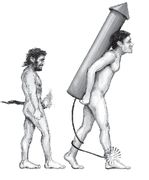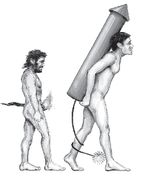The Darwin Awards Countdown to Extinction (7 page)
Read The Darwin Awards Countdown to Extinction Online
Authors: Wendy Northcutt
The entire floor went up in flames, and a large fireball came rolling out the garage door toward us. My friend and I dove to the ground to avoid the flames.
After the initial blast, Mo picked himself up and reacted as the trained and experienced firefighter he was—grabbing an extinguisher to put out the flames. Only then did he realize that his polyester shirt had melted to his burned chest. He refused his wife’s assistance and, despite his inebriated state, drove himself to the local hospital.
My friend’s father lost most of the skin on his chest and most of the hair on his head. He also spent several days in the burn unit and was ultimately tossed out of the volunteer fire department.
Reference: George Leavell

Reader Comment
“This one’s for you, Dad. I just hope you’re smarter than this when you work on the Studebaker!”
SCIENCE INTERLUDE DNA FOSSILS: THE EVOLUTION OF HIV
By Kristin Sainani
In 1981, doctors in California and New York reported a baffling new syndrome: Young gay men were dying from a cluster of rare diseases usually seen only in the elderly or those with severe immune deficiencies. Doctors were witnessing the first glimpse of a frightening new illness soon to cause worldwide devastation—AIDS.
Phylogenetics: building evolutionary trees based on the genetic similarities between organisms
Amazingly the virus that causes AIDS is not new at all. HIV and its ancestors have plagued mammals for 100 million years. There are no confirmed cases of infection before 1959, and HIV leaves no fossil record, so how do we know so much about the virus’s history? Clues to its past lie in its genetic code.
By comparing the genomes of two organisms scientists can determine when they evolved from a common parent. This detective method, called phylogenetics, tells us, for example, that the DNA sequences of chimpanzees and humans differ by only 2 percent and—based on the mutation rate—that we shared Thanksgiving dinners with them five to seven million years ago.

But viral evolution takes place on a much faster time scale. Reproducing in days, not decades, with the higher mutation rate of an RNA genome, HIV evolves a million times faster than humans. A fascinating evolutionary history has unfolded in just a single century, and using phylogenetics, scientists have been able to reconstruct this history.
The History of HIV
The AIDS virus (HIV-1 M) first gained a foothold in what is now the city of Kinshasa in the Democratic Republic of the Congo. The city experienced a population explosion in the 1940s that helped the virus build the critical mass it needed to seed a worldwide epidemic. By analyzing samples stored in the early eighties, scientists have shown that the virus traveled from Africa to Haiti around 1966 (likely carried by a single person) and then from Haiti to the U.S. around 1969, twelve years before the first cases were recognized by physicians. Like Haiti, the U.S. happened to be an early stop on the virus’s globe trot. HIV spread from the U.S. to Canada and parts of Europe. HIV also spread directly from Africa to Europe and Asia, seeding slightly different strains of the epidemic.
Genetic similarities prove that HIV evolved directly from SIV (simian immunodeficiency virus), which infects African monkeys. SIV was transmitted from monkeys to humans on multiple occasions resulting in several different strains of HIV. One of these strains—HIV-1 M—gave rise to the current global pandemic, while the others remain confined to small groups in Africa. It’s clear that HIV-1 M came from chimpanzees in eastern Cameroon, but it is hotly debated as to when the original transmission occurred. Older studies put the date at about 1930, but a 2008 study shows it was most likely 1908.
In that study, scientists compared the oldest and second-oldest HIV samples: blood (1959) and tissue (1960) from the city of Kinshasa. The HIV gene sequences differed by a whopping 12 percent. Clearly the two strains had diverged from a common ancestor long before 1959. Next, the scientists arranged decades of HIV samples into a genetic tree based on their similarities and converted the genetic distances on the tree into units of time, using the known mutation rate of HIV and some fancy computer modeling. The roots of the tree converged about one hundred years ago.
Between 1884 and 1924, AIDS was born.
Deadly virulence is the hallmark of a recently evolved disease. Deadly is not a beneficial trait, as killing the host kills the virus. More evolved diseases are less virulent, thus more successful at spreading their genes.
HIV and the Evolutionary Speed Limit
HIV has been evolving for a century, the equivalent of 100 million years of mammalian evolution, so one might expect that HIV would now be an ultra-evolved superbug, even more infectious than the original version. But, surprisingly, most of the genetic changes that have accumulated in the past century are random—driven by genetic drift rather than natural selection.

Genetic drift:
genetic changes that accumulate in a species’s genome randomly, rather than through natural selection.
genetic changes that accumulate in a species’s genome randomly, rather than through natural selection.
HIV is a retrovirus, meaning it stores its genetic information in RNA. Copying RNA back to DNA is a messy, error-prone process. The mutation rate is so high that retroviruses are said to live at the evolutionary speed limit—if they mutated any faster, they would fall apart. So HIV racks up scads of mutations that don’t confer an immediate advantage. It’s genetic drift is fast enough to be a riptide!
But don’t think that HIV doesn’t also undergo classic Darwin-style natural selection. HIV is a marvel at escaping the immune system and eluding drugs. There is no better example of natural selection in real time than its evolution within a single host: HIV can change some of its proteins by 25 percent to escape the immune system and evade drugs—and yet, amazingly, the proteins still function. The virus has made incessant random mutations work in its favor.
Protein-coding genes, the part of our DNA that is most obviously useful, makes up less than 2 percent of our genome. There are also RNA coding genes and regulatory DNA. Still, human cells contain a lot of DNA with no known purpose. For instance, the ALU sequence—a 300-nucleotide chunk that repeats ad nauseum—comprises 10 percent of our instruction manual, yet seems to be a useless accident. And a lot of DNA—more than 8 percent—is miscellaneous litter from
alien retroviruses
! By transferring DNA between species, retroviral infections are the Johnny Appleseed of evolution, the Wilt Chamberlain of spreading genes.
alien retroviruses
! By transferring DNA between species, retroviral infections are the Johnny Appleseed of evolution, the Wilt Chamberlain of spreading genes.
HIV tends to revert back to its old form (which is usually more stable) when transmitted to a new host, however, so these mutations aren’t preserved at the population level.
Fossils in Our Chromosomes! Prehistoric HIV
There is yet another incredible source of information about HIV evolution: Modern mammals contain clues to its ancient history embedded in their genomes.
You see, when a retrovirus infects a cell, it must insert its genetic material into a chromosome in that cell in order to reproduce. When the virus happens to infect a sex cell, and that sperm or egg becomes a baby, the viral sequence can become a permanent part of the host genome. This DNA “fossil” is called an endogenous (pronounced “en DOJ en iss”) retrovirus.
These fossils litter our chromosomes. Scientists estimate that 8.3 percent of the human genome is leftover from retroviral infections—retrovirus DNA trapped in our chromosomes. This is a huge amount of DNA, seven times more than is found in all twenty thousand protein-coding genes in the human genome! (The part of our genome that makes the building blocks of our bodies.)
In 2008, scientists discovered an endogenous lentivirus (the family to which HIV belongs) fossil in the genome of the gray mouse lemur, a small primate found in Madagascar. This discovery shows that HIV’s ancestors have been infecting primates for 14 million years. In 2009, scientists discovered a precursor of the lentivirus, an endogenous foamy virus, fossilized in the genome of the sloth. (Think Sid from the movie
Ice Age
.) HIV’s ancestors have been infecting mammals for 100 million years—since the age of the dinosaurs!
Ice Age
.) HIV’s ancestors have been infecting mammals for 100 million years—since the age of the dinosaurs!

Startling Conclusion
We now know that our genes are full of alien DNA fossils! We now know the history of the viral scourge known as HIV. Where does it get us? Amazingly a virus that mutates at warp speed hasn’t changed much over 100 million years. And those invariant parts that cannot be changed? Good news for vaccine designers, who can exploit these to develop a shot that finally cripples HIV. This is just one of the many practical implications of understanding the evolution of HIV.
REFERENCES:
R. J. Gifford, et al., “A transitional endogenous lentivirus from the genome of a basal primate and implications for lentivirus evolution,”
Proceedings of the National Academy of Sciences
105 (2008), 20362-20367.
Proceedings of the National Academy of Sciences
105 (2008), 20362-20367.
M. T. P. Gilbert, et al., “The emergence of HIV/AIDS in the Americas and beyond,”
Proceedings of the National Academy of Sciences
104 (2007), 18566-18570.
Proceedings of the National Academy of Sciences
104 (2007), 18566-18570.
A. Katzourakis, “Macroevolution of complex retroviruses,”
Science
325 (2009), 1512.
Science
325 (2009), 1512.
Paul Sharp and Beatrice H. Hahn, “Prehistory of HIV-1,”
Nature
455 (2008), 605.
Nature
455 (2008), 605.
M. Worobey, et al., “Direct evidence of extensive diversity of HIV-1 in Kinshasa by 1960,”
Nature
455 (2008), 661- 664.
Nature
455 (2008), 661- 664.
CHAPTER 9
WORKING NINE TO FIVE
If you find yourself thinking, “This tricky shortcut will save a little time . . .” then you might be headed for a Darwin Award.
Construction, demolition, and all things in between. Whether you’re a professional or a do-it-yourselfer, even a seemingly safe, sane, straightforward job can turn into a hazard in the hands of a Darwin Award wannabe. From seasonal ski-lift operator to career safety inspector,
working for a living
takes on a startling new meaning!
working for a living
takes on a startling new meaning!
Other books
The Long Journey to Jake Palmer by James L. Rubart
River of Blue Fire by Tad Williams
Watch Me by Norah McClintock
On The Banks Of Plum Creek by Wilder, Laura Ingalls
The Foreign Correspondent by Alan Furst
The Darkest Hour by Katherine Howell
magical cures 07 - a charming fatality by kappes, tonya
Missing Mark by Julie Kramer
The Cattleman (Sons of Texas Book 2) by Anna Jeffrey